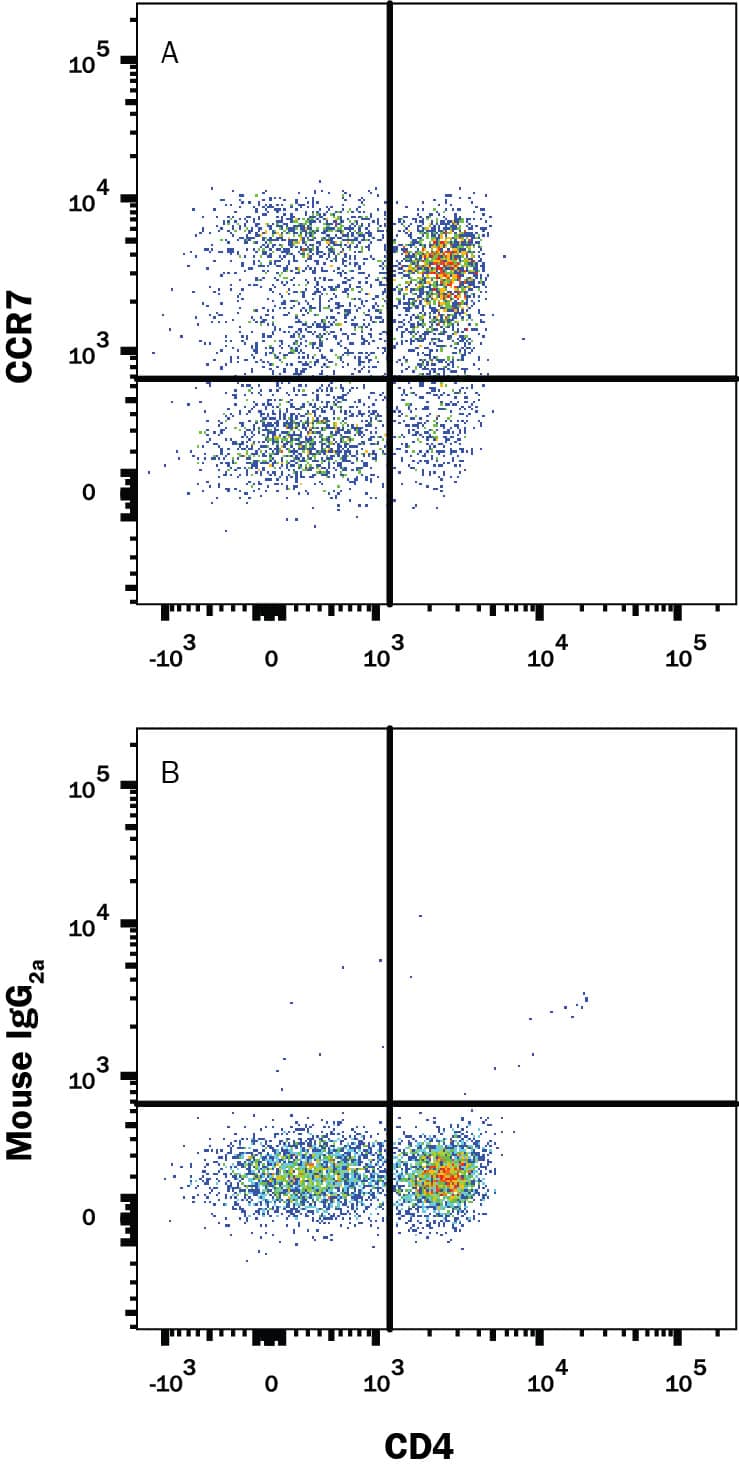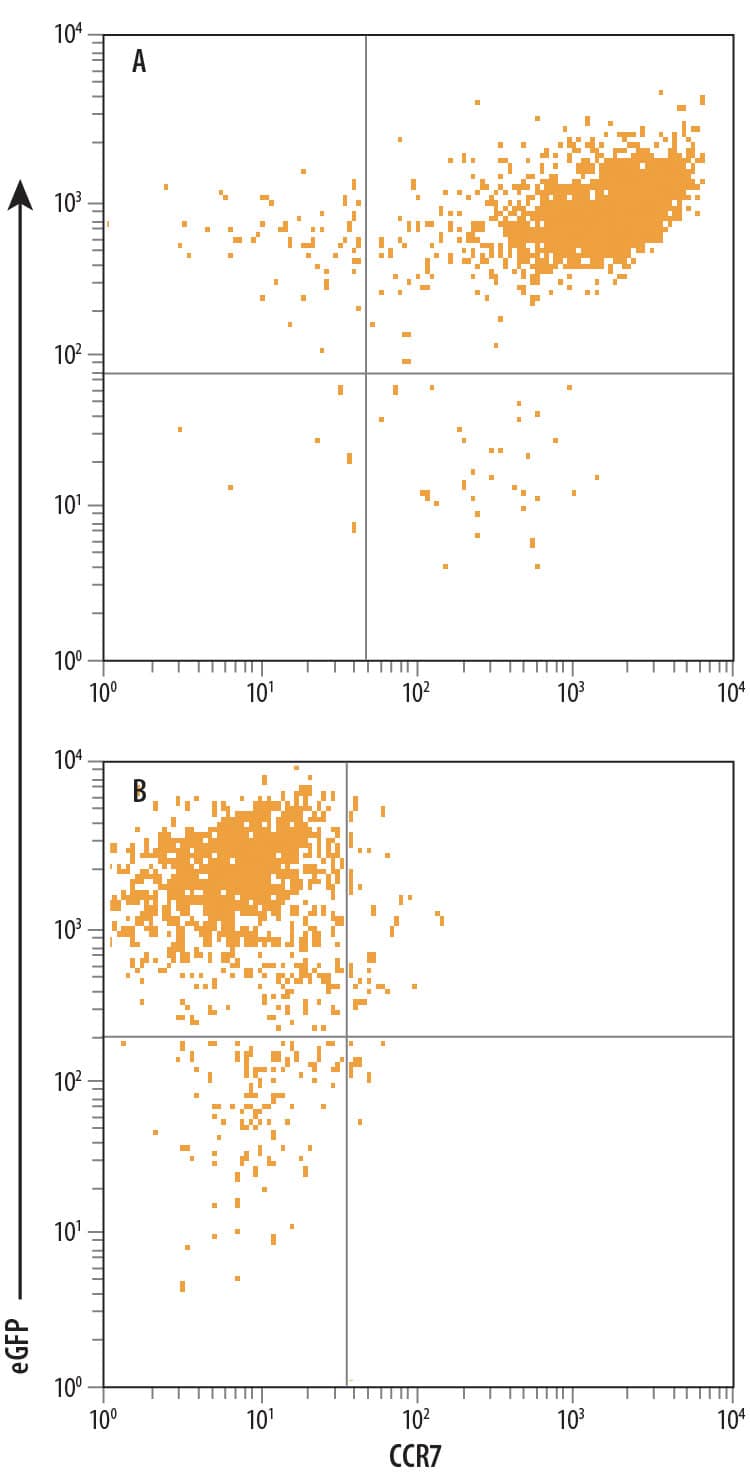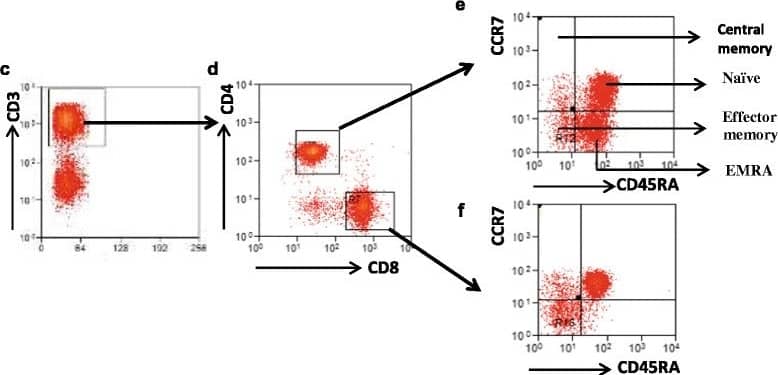Human CCR7 Fluorescein-conjugated Antibody
R&D Systems, part of Bio-Techne | Catalog # FAB197F
Clone 150503 was used by HLDA to establish CD designation


Conjugate
Catalog #
Key Product Details
Species Reactivity
Validated:
Human
Cited:
Human, Primate - Chlorocebus pygerythrus (Vervet Monkey), Primate - Macaca mulatta (Rhesus Macaque)
Applications
Validated:
Flow Cytometry
Cited:
CAR-T (Flow Cytometry), Flow Cytometry, Immunocytochemistry
Label
Fluorescein (Excitation = 488 nm, Emission = 515-545 nm)
Antibody Source
Monoclonal Mouse IgG2A Clone # 150503
Product Specifications
Immunogen
Human CCR7 transfectants
Met1-Pro378
Accession # AAA58615
Met1-Pro378
Accession # AAA58615
Specificity
Detects human CCR7.
Clonality
Monoclonal
Host
Mouse
Isotype
IgG2A
Scientific Data Images for Human CCR7 Fluorescein-conjugated Antibody
Detection of CCR7 in Human Blood Lymphocytes by Flow Cytometry.
Human peripheral blood lymphocytes were stained with Mouse Anti-Human CD4 APC-conjugated Monoclonal Antibody (Catalog # FAB3791A) and either (A) Mouse Anti-Human CCR7 Fluorescein-conjugated Monoclonal Antibody (Catalog # FAB197F) or (B) Mouse IgG2AFluorescein Isotype Control (Catalog # IC003F). View our protocol for Staining Membrane-associated Proteins.Detection of CCR7 in HEK293 Human Cell Line Transfected with Human CCR7 and eGFP by Flow Cytometry.
The specificity of Mouse Anti-Human CCR7 Clone 150503 was demonstrated by its ability to react with (A) HEK293 human embryonic kidney cell line transfected with human CCR7 and not react with (B) irrelevant HEK293 transfectants. Antibody binding was monitored using Phycoerythrin-conjugated Anti-Mouse IgG Secondary Antibody (Catalog # F0102B).Detection of Human CCR7 by Flow Cytometry
Frequency of peripheral T lymphocytes in hip fracture patients with and without depressive symptoms versus healthy controls. (a) The percentage of CD3+ve T cells in healthy controls: n = 37; hip fracture patients without depression (HF): n = 38 and hip fracture patients with depressive symptoms (HF + D): n = 29.The solid bar represents the mean value. (b) The mean absolute number of T cells in healthy controls: n = 20; hip fracture patients without depression (HF): n = 19 and hip fracture patients with depressive symptoms (HF + D): n = 15. Data are mean ± SEM. *p < .05 and **p < .01. Representative flow cytometry plots and gating strategy of PBMCs from a young individual stained with anti-CD3 and (c) anti-CD4, and CD8, (d) and anti-CD45RA and -CCR7 (e and f). Image collected and cropped by CiteAb from the following publication (https://pubmed.ncbi.nlm.nih.gov/25628751), licensed under a CC-BY license. Not internally tested by R&D Systems.Applications for Human CCR7 Fluorescein-conjugated Antibody
Application
Recommended Usage
Flow Cytometry
10 µL/106 cells
Sample: Human peripheral blood lymphocytes
Sample: Human peripheral blood lymphocytes
Reviewed Applications
Read 1 review rated 2 using FAB197F in the following applications:
Formulation, Preparation, and Storage
Purification
Protein A or G purified from hybridoma culture supernatant
Formulation
Supplied in a saline solution containing BSA and Sodium Azide.
Shipping
The product is shipped with polar packs. Upon receipt, store it immediately at the temperature recommended below.
Stability & Storage
Protect from light. Do not freeze.
- 12 months from date of receipt, 2 to 8 °C as supplied.
Background: CCR7
Alternate Names
BLR2, CC-CKR-7, CCR7, CD197, CDw197, CMKBR7, EBI1
Gene Symbol
CCR7
UniProt
Additional CCR7 Products
Product Documents for Human CCR7 Fluorescein-conjugated Antibody
Product Specific Notices for Human CCR7 Fluorescein-conjugated Antibody
For research use only
